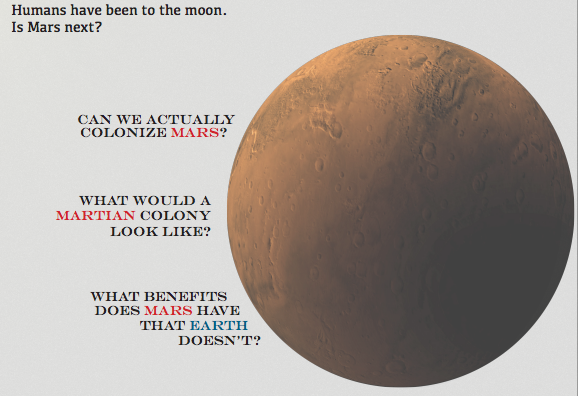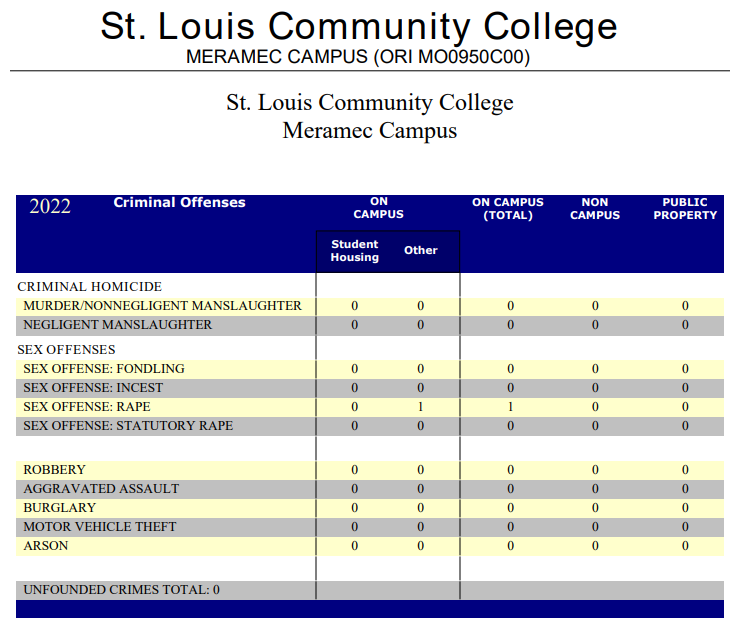Colonizing Space Through the New Frontier
BY: MISSY ARNESON
Copy Editor
NASA has made noise recently about founding a Martian colony, along with Mars One and SpaceX.
Rick Menendez, an adjunct physical science professor at STLCC–Meramec and serious amateur astronomer, said he definitely thought this was possible. Menendez said most of the challenges of having a Martian colony will be technological, but some of them will not be.
“The real problem I see is, aside from technological, part of the issues will be social; getting people together on a two-year trip,” Menendez said. “To get there is about a one-year trip one way, and about a year to get back. So the two-year trip will be a problem.” Menendez said the colonists will have to be in very close quarters for those trips, which often results in interpersonal conflict.
“The closest analogy we have is people who work on submarines,” Menendez said. “We’ve got these big submarines that carry missiles. These guys are underwater in a very tight, controlled environment for about three months at a time, so we can actually glean a lot from those people.”
Menendez said another good analogy of a Martian colony is the people who live in Antarctica, since they’re cut off from civilization.
Old solutions to the problems of getting to Mars — such as taking all of the fuel, food, and water the colonists would need with them — have been replaced with newer and better answers, Menendez.
“The idea they have now is something called in-situ research utilization,” Menendez said. “Mars has carbon dioxide in the air — you can cut carbon dioxide in half; use the oxygen to breath.” Water is incredibly important, Menendez said.
The colonists will need lots of water for bathing, drinking, and growing crops. Another use for in-situ research utilization is for turning water into other usable resources.
“So they found water below the surface, frozen permafrost, and they use that,” Menendez said. “You break the water in half, you get oxygen to breathe, and hydrogen can be used as rocket fuel if you ever wanna come back.” Menendez said a Martian colony will likely be mostly buried underground due to high levels of radiation.
“The big problem is radiation – there’s no radiation shields, so they have to be protected from the solar radiation,” Menendez said. “The way they’re talking about… is to land a colony first of three or four people, and then every two years send additional colonists, gradually spanning it out into a network, [starting in] one place and then gradually moving it into different places. So it’s gonna be interconnected nodules.”
This radiation is because Mars doesn’t have the same magnetic shield that Earth has. Menendez said this is likely because of how the planets evolved.
“We have a situation in the solar system, kind of like a Goldilocks situation,” Menendez said. “We have three somewhat similar planets; Venus, Earth, and Mars. Venus is too hot, it’s like Goldilocks’ porridge; Mars is too cold, and Earth is just right. When planets lose their magnetic fields, they lose their water. Mars spun fast enough, but it was too small; they think its magnetic field froze, and it lost its magnetic shield. Earth was just the right size.”
These interconnected nodules will become specialized over time, according to Menendez. “And eventually, I assume, as time goes on that they’ll start to specialize each nodule,” Menendez said. Maybe one nodule for crop growing, another one for recreation, one for sleeping, one for eating. So it’ll start small and gradually span outward in a viral network. That’s probably the initial plan.”
Mars has some great benefits that Earth doesn’t, according to Menendez, most notably the possibility of indigenous life.
“Now, there’s probably not anything on the surface; there’s too much radiation, but below the surface, there could be bacteria living,” Menendez said. “… if they find this, does it have the same structure? Does it use DNA? Or does it use a different way of metabolizing things? That would be a big first thing to look for.”
According to the Mars One website, Maggie Duckworth is an electrical engineer who lives here in Saint Louis — and will actually be going to Mars. Menendez compared going to Mars to the early colonizers of America.
“People say it’s kind of weird, but if you think about it, in the past, when people came to the Americas, they knew, most of those people, that they would never see their family again,” Menendez said. “They were going, and they weren’t coming back. Actually Maggie’s group is gonna have this, they’ll be in contact with radio and television; there’s a half hour delay each way, but they can still talk to their parents and get pictures from home.”
Duckworth will be coming to speak at Meramec in November. Menendez said the colony will start off with two men and two women to help prevent conflict, but as more people join them on Mars, fighting will become more and more inevitable.
“Could the colony eventually destroy itself because of infighting?” Menendez said. “Those are questions. There’s a lot of things to think about. But it is one grand experiment.”
Mental and Physical Long-Term Effects of Living on Mars
BY: MARIE SCHWARZ
Managing Editor
The planet Mars is obviously not the Earth. Atmosphere, gravitation and especially no air to breathe already indicate that without certain precautions, long term effects on the human body are not necessary to talk about because one will die by these extreme environmental conditions instantly, said Joseph Schneider, Physical Science Instructor at Meramec. “If you’re out there without a space suit on, you’re not gonna last very long,” Schneider said. So to discuss possible long term effects, dress code is a space suit with oxygen tank. From a physiological point of view, decrease of bone density and decrease in muscle strength, as well as radiation are the most important factors to consider when living in space, said Jeff Baumstark, Biology Professor at Meramec. The loss of bone density and muscle strength is due to the change of gravity, Baumstark said. Compared to Earth, Mars’ gravity is only about 38 to 40 percent, Schneider said. “You can lose about one percent [of bone density] on Mars per month, whereas [on Earth] you’re typically not starting to lose bone mass until you’re in your 40s or 50s,” Baumstark said. “Less stress on bones means less bone density which means higher risk for osteoporosis.” Besides decrease in bone density, there is also less resistance on muscles, which means exercising is even more important on Mars than on Earth, Baumstark said. “If people are sent to Mars, they have to exercise regularly,” Baumstark said. “Probably any normal exercises that you would do on Earth. … I don’t think it would have to be necessarily anything incredibly special or different from what you do on Earth to keep your muscles and bones and your heart healthy.” While gravitation plays a significant role for long term effects on the human body, the higher exposure to radiation has to be considered as well, Baumstark said. “If you don’t have the space suit on, then you’re subjecting yourself to the dangerous amount of radiation from our sun,” Schneider said. “This is going to be the tremendous amount of radiation that literally will just start shutting your organs down almost right away because there’s no protection.” However, since a spacesuit is a must piece of clothing when living in space or on Mars, a problem caused by radiation will be cancer development, Baumstark said. “We know high levels of radiation are directly associated with formations of cancers,” Baumstark said. “So someone living on Mars for a long period of time – even if you’re protected as much as possible – is going to have high levels of exposure of radiation. [This will] speed up the process of cancers and [development of cancer] in certain organs is certainly possible.” Besides considering only the physiological problems that would most likely come when living on Mars, there is also a psychological component to consider, Baumstark said. Social interactions have been always important for humans, Baumstark said. “There’s research out there that shows a strong correlation between social interaction and overall health,” said Baumstark. “Like seniors for instance, older individuals in our society. The more isolated they are, the higher the mortality they have. [And] the faster [they] have more health issues and other kind of problems. So social interaction has always been one of the key tenants of people being happy and feeling good.” The social interaction is not only meant in a physical way. A simple conversation via a call or even instant messaging would be affected as well, Schneider said. “Connections between Mars and the Earth – depending on the distance and so forth – could be three minutes up to 23 minutes … to get things back and forth,” Schneider said. “That’s not like having a conversation with someone. … You have to realize, you’re literally going to be a Martian. You’re going to be separated from the Earth.” Besides limited social interactions, the microbiome flora which is the natural bacterial flora that exist in our body is also likely affected when living isolated on Mars, Baumstark said. “If we’re isolated in a certain area for so many years and a very small space with only a certain amount and types of people, you’re microbiome flora will be most likely affected by it as well,” Baumstark said. “[Which is showing to have] effects on diseases and other types of things like obesity and neuronal function [and] mood, and all types of things.” Living on Mars to this point includes a lot of speculation, Schneider said. “We have to be independent of the Earth,” Schneider said. “You cannot expect to be getting shipments of food from the Earth. … There isn’t really anything that we know about at this point besides water on Mars.” More research has to be done before sending people with good conscience to Mars, Schneider said. “This seems quite an extreme case going to Mars, so we actually will see if people decide to go and if they are able to have a viable group of people to go,” Baumstark said. How it turns out will be very interesting.”
Timeline of expanding man’s place among the stars
BY: ADAM MORAN
Staff Writer
Mars has been an important milestone for mankind since the early Space Age. Our history with the Red Planet, though brief, is filled with many endeavours. The list of missions is extensive, especially when the scale is extended past the United States. Many other national and privatized space programs around the world have made significant progress in expanding mankind’s place amongst the stars as well. For the sake of this article, the main focus will be on the significant, successful, and future missions to the Red Planet by all major contributors. On July 14, 1965, NASA’s Mariner 4 was the first human satellite to make a successful flyby. Mariner 6 and Mariner 7 followed in 1969 with the same mission as it’s predecessor, and on Nov. 14th, 1971, Mariner 9 entered Mars’s orbit and remained there for approximately 515 days before deactivating. NASA trend of success continued, for the most part, as their next set of missions focus was to orbit and land on Mars. These missions were given the designation “Viking”. Viking 1 launched August 20th, 1975, and Viking 2 was launched shortly after on September 9th. The next mission to Mars that had absolute success wasn’t until 1996, when NASA launched its Mars Global Surveyor. Later that year, on December 4th, NASA also launched its Mars Pathfinder spacecraft, carrying a small rover, designated Sojourner. With history catching up to the present, we see many spacecraft launched to Mars still operating today, and are projected to do so into the 2020’s. For example, NASA’s Odyssey Orbiter was launched April 7th, 2001, and the European Space Agency’s first successful Mars Orbiter, the Mars Express, on June 2, 2003, are both still operating today. NASA also launched two more spacecraft towards Mars in 2003, both of which were landers: the Spirit on June 10th and the Opportunity on July 8th. The rest of the 2000’s are filled with more orbiter and lander missions. A few notable ones would be NASA’s Phoenix lander, launched August 4th, 2007; NASA’s Curiosity rover, launched November 26th, 2011; NASA’s MAVEN orbiter, launched November 18th, 2013; and the ESA’s ExoMars orbiter and Shciaparelli EDM rover, launched March 14th of this year, and still en route to Mars now. This all may seem trivial, perhaps even boring, to some; however, the progress that has been made, by all global contributors has paved the way for some very ambitious ideas. With Mars being the next logical stepping stone in our solar system, many organizations are pushing to colonize Mars in a matter of decades. NASA is one leading organization preparing to put a man on Mars. According to NASA.gov, “NASA is developing the capabilities needed to send humans to an asteroid by 2025 and Mars in the 2030s”. But NASA isn’t the only one aiming to put a man on Mars. According to Space.com, “The incoming leader of the European Space Agency is keen on establishing an international base on the moon as a next-step outpost beyond the International Space Station.” So, if the ESA is planning on establishing extraplanetary colonies, perhaps establishing one on Mars is also in the talks. As ambitious as this may sound, this goal is not limited only to national agencies. Many private organizations are planning on establishing colonies on Mars as well. Mars One is a major private contributor to Mars colonization, and plans on landing its first settlers in 2027. Another major organization with goals to colonize Mars is SpaceX. Recently, Elon Musk, the founder and CEO of SpaceX, unveiled his plans to colonize Mars. According to Space. com, Musk, with his Interplanetary Transport System, “plans to get 1 million people to Mars.”, and “the ITS could be launching on its first Mars mission “within the 10- year time frame.” So, with many plans of colonization in the works, it is likely we will see, at the very least, mankind to take the first steps on Mars within the next decade or two.













